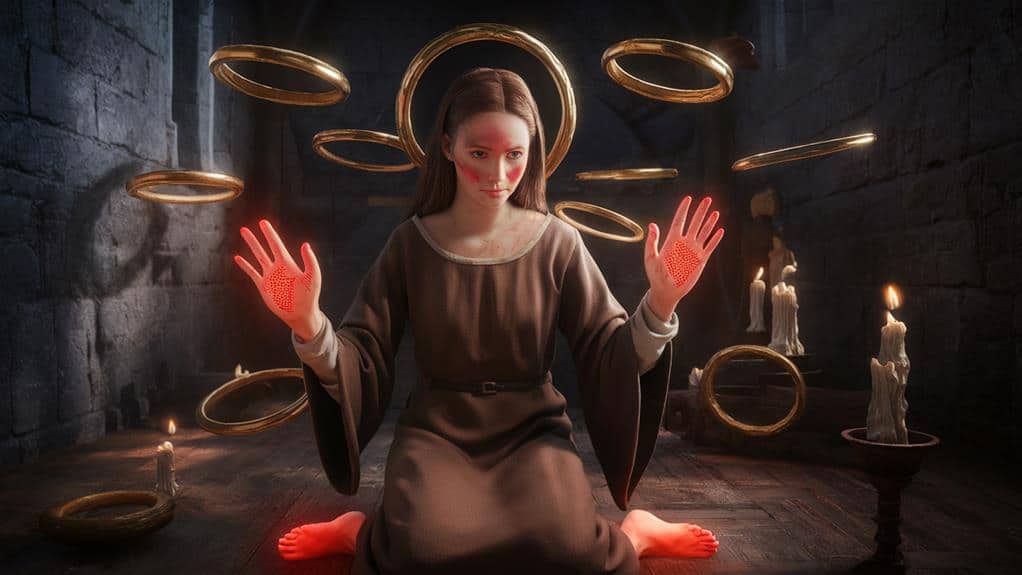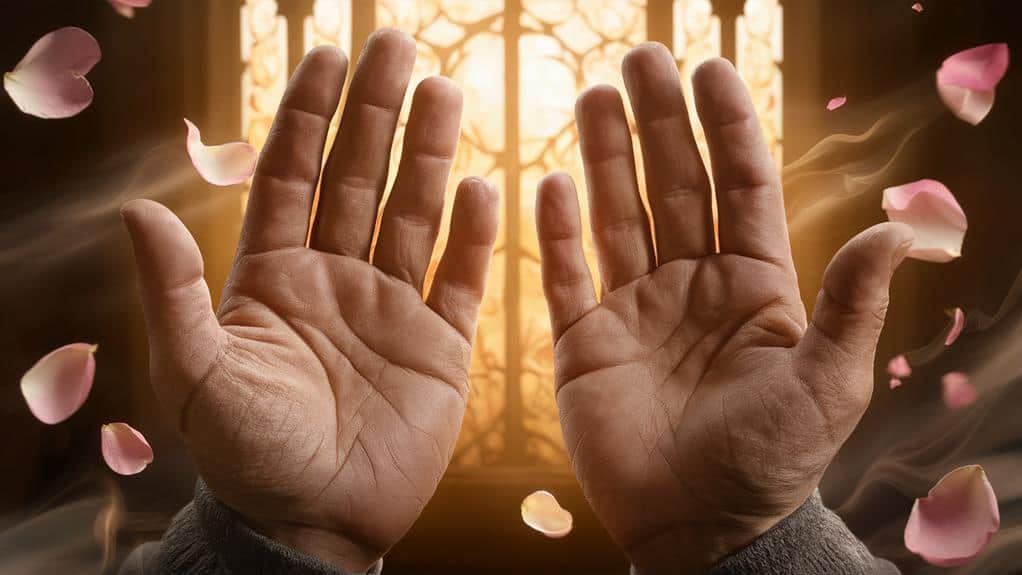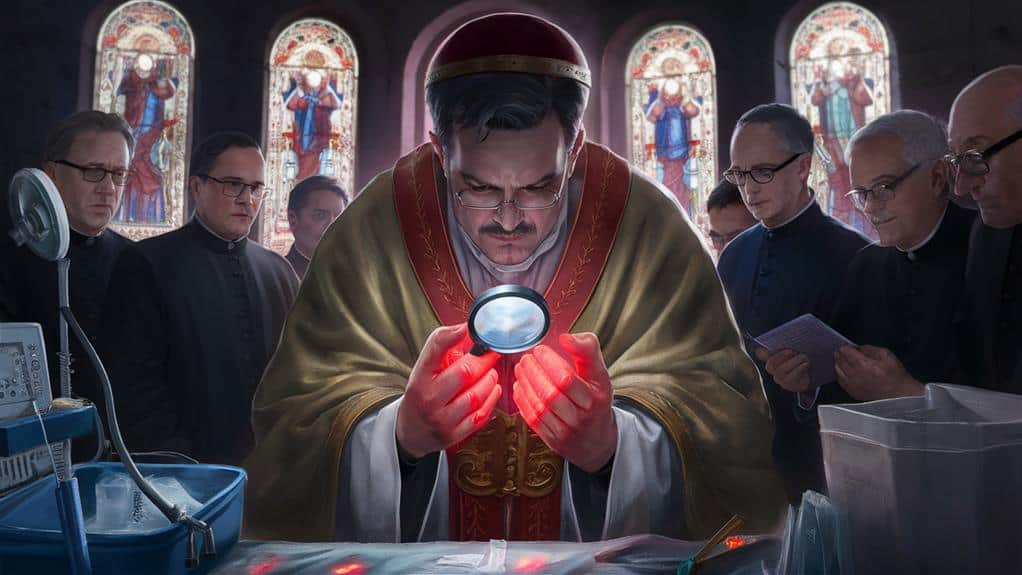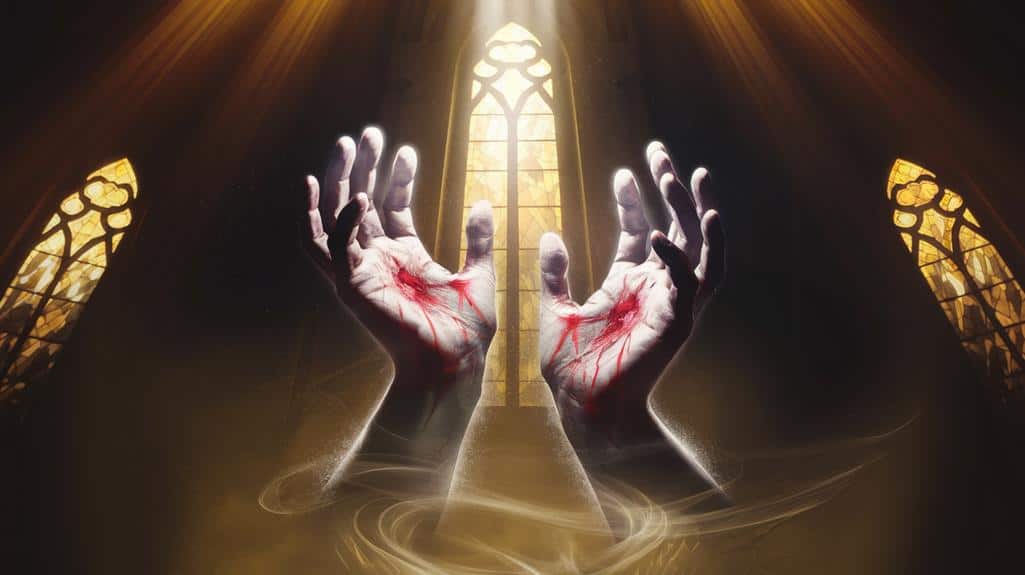The Mystic Phenomenon of Stigmata
You’ve likely heard whispers of individuals who mysteriously develop wounds matching those of Christ’s crucifixion – a phenomenon known as stigmata. While you might dismiss these accounts as medieval folklore, documented cases continue to emerge in modern times, challenging both religious and scientific communities. From the first recorded instance of St. Francis of Assisi in 1224 to contemporary cases under medical scrutiny, these unexplained manifestations present a compelling intersection of faith and physical reality. What you’ll discover about the evidence, verification processes, and scientific theories behind stigmata might challenge your understanding of the possible connection between profound belief and bodily transformation.
Historical Cases Through The Ages

Since medieval times, documented cases of stigmata have captivated both religious scholars and medical professionals. You’ll find that St. Francis of Assisi‘s experience in 1224 stands as the first recorded instance, marking a profound turning point in Christian mysticism.
As you explore deeper into history, you’ll discover that women have mainly reported these supernatural wounds, with notable cases like Catherine of Siena in the 14th century and Padre Pio in the early 20th century.
You might be intrigued to learn that stigmata manifests differently across cases – some bear visible wounds while others experience invisible pain in locations corresponding to Christ’s crucifixion wounds.
Throughout the centuries, you’ll notice patterns emerging: most stigmatics have shown signs on Fridays or during significant religious observances, and many have reported accompanying visions or spiritual experiences.
Modern documentation has brought forth contemporary cases like Therese Neumann of Germany and Natuzza Evolo of Italy, whose experiences have been subjected to both theological examination and scientific scrutiny.
You’re witnessing a phenomenon that continues to challenge the boundaries between faith and empirical investigation, inviting deeper contemplation of human spirituality’s mysteries.
Medical Science Examines Stigmata
Modern medical science brings a rigorous analytical approach to these mystifying wounds that have fascinated religious observers for centuries. You’ll find that researchers have documented various physiological aspects of stigmata, including blood composition analysis, wound patterns, and healing characteristics that don’t align with typical injury responses.
When you examine the scientific literature, you’ll discover that dermatologists have proposed several natural explanations, including psychogenic purpura – a condition where emotional stress causes blood vessels to rupture beneath the skin.
You’re looking at evidence that suggests some cases might stem from neurological phenomena, where intense focus on Christ’s passion triggers psychosomatic responses in deeply religious individuals.
What’s particularly intriguing is how you can trace the connection between the nervous system and skin manifestations, as contemporary neuroscience reveals the powerful mind-body interactions at play.
You’re witnessing how modern diagnostic tools, from infrared imaging to cellular analysis, are peeling back layers of mystery while simultaneously raising new questions about consciousness, belief, and physical manifestation.
These investigations don’t necessarily diminish the spiritual significance for believers but offer deeper insights into how faith might influence human physiology.
Notable Modern Stigmatics

Throughout the 20th and 21st centuries, several widely documented cases of stigmata have captured public attention and sparked intense investigation.
You’ll find that Padre Pio, perhaps the most famous stigmatic of modern times, bore visible wounds for fifty years until his death in 1968. His experiences drew millions of pilgrims to his monastery in San Giovanni Rotondo, where you could witness his profound suffering and dedication to serving others despite his constant pain.
When you explore more recent cases, you’ll discover Natuzza Evolo, who exhibited stigmata until her death in 2009.
In South Korea, you’ll find Julia Kim, whose reported manifestations during the 1980s attracted thousands of witnesses. You can’t overlook Therese Neumann of Germany, whose weekly Friday stigmata throughout the mid-1900s demonstrated remarkable consistency, while claiming to live solely on the Eucharist for decades.
What’s particularly striking is that you’ll notice these modern stigmatics share common characteristics: they’ve typically led lives of deep devotion, maintained humility despite their extraordinary experiences, and often demonstrated other mystical phenomena that you’d find difficult to explain through conventional means.
Psychological and Physiological Perspectives
From a scientific standpoint, researchers have proposed various explanations for stigmata that bridge both psychological and physiological factors.
You’ll find that experts often point to psychosomatic conditions, where intense religious devotion and deep-seated beliefs can manifest as physical wounds through the mind-body connection. The power of focused contemplation and extreme emotional states can trigger your body’s remarkable capacity to produce physical changes, including alterations in blood flow and tissue damage.
When you examine the physiological perspective, you’ll discover that some researchers have identified specific mechanisms at work. Your body’s stress response system, coupled with heightened states of religious ecstasy, can activate inflammatory processes and blood vessel changes.
There’s compelling evidence that some stigmatics experience a combination of autosuggestion and actual dermatological conditions, where your skin’s response to intense psychological states creates visible marks.
Scientists have also noted that certain individuals display heightened susceptibility to psychogenic purpura, where emotional stress causes blood vessels to leak, creating the appearance of spontaneous bleeding.
These findings don’t diminish the profound spiritual significance for believers but offer a framework for understanding how your mind and body might interact during such extraordinary experiences.
Church Verification Process

The Catholic Church carries out rigorous investigations when confronted with claims of stigmata, employing a meticulous verification process that can span several years.
You’ll find that medical experts, theologians, and Church officials work together to examine every aspect of the claimed phenomenon, documenting physical manifestations while scrutinizing the individual’s spiritual life and mental health.
When you investigate deeper into the verification process, you’ll discover it unfolds in distinct phases.
Initially, Church authorities conduct preliminary investigations to rule out obvious frauds or natural explanations. They’ll examine your wounds for signs of self-infliction, evaluate your psychological state, and assess your devotional practices.
If your case progresses, you’ll undergo extensive medical examinations, often involving multiple specialists who’ll document the wounds’ characteristics and healing patterns.
The final phase requires documentation of supernatural elements that can’t be explained by science.
You’ll need to demonstrate consistent spiritual fruits: deepened prayer life, humility, and authentic virtue.
The Church won’t officially recognize your stigmata until they’ve exhaustively explored every possible natural explanation and found your spiritual life exemplary.









